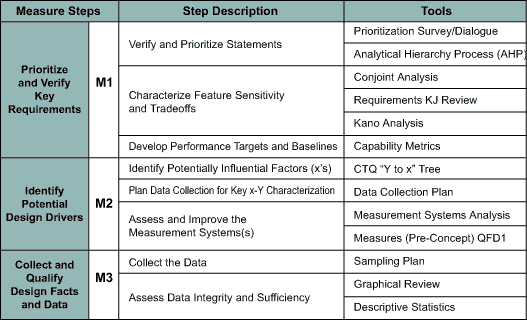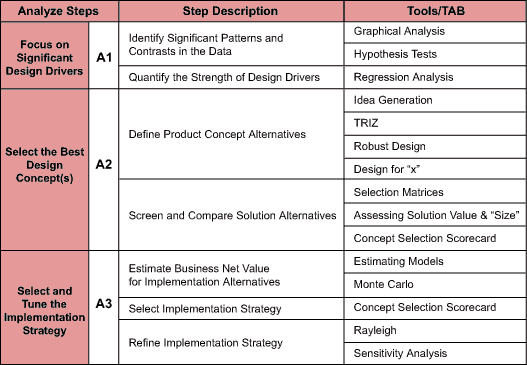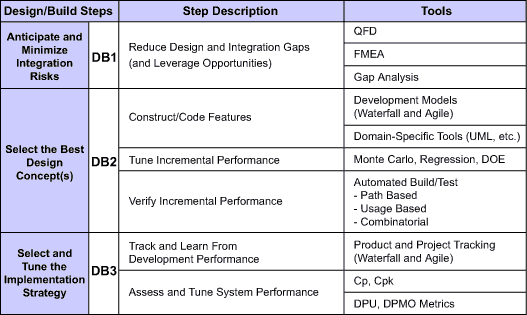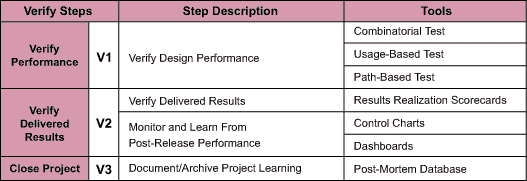
While there are more than a few connections between the Six Sigma DMAIC roadmap and Capability Maturity Model Integration (CMMI), some practitioners may not be aware of the connections between CMMI and Design for Six Sigma (DFSS). CMMI has four process categories, each contains several process areas that are associated with a maturity level (Table 1). Process areas most strongly connected to DFSS are those in the engineering process category.
| Table 1: Breakdown of Four Process Categories of CMMI | ||
| Process Category |
Process Area |
Mat. Level |
| Process Mgmt. |
Organizational Process Definition Organizational Process Focus Organizational Training Organizational Process Performance Organizational Innovation/Deployment |
3 |
| Project Mgmt. |
Project Planning Project Monitoring and Control Supplier Agreement Management Integrated Project Management for IPPD Risk Management Integrated Teaming Integrated supplier Management Quantitative Project Management |
2 |
| Engineering | Requirements Management Requirements Development Technical Solution Product Integration Verification Validation |
2 |
| Support | Configuration Management Process and Product Quality Assurance Measurement and Analysis Decision Analysis and Resolution Organizational Environment for Integration Causal Analysis and Resolution |
2 3 |
DFSS Connections to Engineering Process Areas
Requirements Development (RD) has three goals – (1) to develop customer requirements; (2) to develop product requirements, including characterization of operational concepts and use scenarios (allocating customer requirements to system elements such as hardware, software and people); and (3) to analyze and validate requirements (ensuring that they are necessary and sufficient and that they appropriately balance stakeholder needs and constraints).
The goal of the Requirements Management (REQM) process area is to manage requirements in order to ensure consistency with plans and work products. REQM entails five specific practices, several of which have direct connections to DFSS.
- Understand the requirements.
- Obtain a commitment from those who will implement the requirements.
- Manage changes to the requirements, including change history.
- Provide bi-directional traceability between requirements and related work products.
- Identify inconsistencies between the requirements and project plans and work products.
These practices connect most directly to the Define and Measure phases of the DFSS DMADV roadmap depicted in Figures 1 and 2.

Step D2in the DFSS/DMADV roadmap addresses elicitation of customer requirements, including careful distinction of needs specifically identified by the customer, and context data that indicates needs that are easily missed – the “latent” requirements. Context data describes the customer environment and often provides insight that clarifies the “why” behind the requirements and thereby facilitates the understanding required for effective requirements management.
Step D3 focuses attention on the critical-to-quality (CTQ) requirements that drive success – distinguishing them from the routine many. In this step, measures are associated with the CTQs, thereby providing additional insight that facilitates understanding, clarifies ambiguities and establishes the framework necessary for early acceptance testing planning. As test planning will often find as many defects as does testing, the definition of measures at this early stage leads to significant improvements in the quality of the requirements.

Step M1 deals with prioritization issues and facilitates balancing of customer needs and constraints in a quantified and reviewable manner that can be revisited whenever changes in requirements occur.
Step M2 includes Y-to-x flowdown, a technique that identifies the lower level factors that must be controlled or optimized in order to satisfy the CTQ requirements. This incorporates one of the central concepts of Six Sigma, Y = f(x) – i.e., Y, an outcome typically not directly controllable, is driven by or is a function of one or more x’s, or factors that are controllable and must be carefully addressed.
Step M3 entails planning for and collecting data relevant to measurement success in meeting the requirements of the customer.
Technical Solution (TS) is the third process process area within CMMI’s engineering category. This process area has three goals – to select the solution, to develop the design and to implement the design. Selecting the solution aligns most directly with the Analyze phase of the DFSS/DMADV roadmap (Figure 3).

Step A1uses measures and data to develop a statistically sound understanding of the transfer functions that connect relevant x’s to Ys of interest – in other words, determining which factors are the most important and quantifying the strength of the relationships that exist. This approach guides selection of alternative solution concepts or architectures.
Step A2 generates alternative concepts and uses tools such as the concept selection scorecard to guide the evaluation and selection among the feature and architecture alternatives identified. This step produces a product strategy that articulates the concept selected and the feature set to be provided.
Step A3 evaluates alternatives with respect to implementation strategy. This assessment evaluates the business value impact of schedule/cost/quality alternatives. For example, which is best in this situation – fast delivery at a higher cost and lower quality, later delivery date with higher quality and lower cost, or delivering less functionality as a compromise?
Developing and implementing the design align most directly with the DFSS/DMADV Design/Build phase (Figure 4). This is primarily in the realm of traditional software engineering practices, and Six Sigma typically plays a smaller role, often related to optimization of certain aspects of performance.
Verification and Validation are the final two process areas within the engineering category. They align most directly with the Verify phase of the DFSS/DMADV roadmap (Figure 5).


Conclusion: A Synergistic Combination
Six Sigma is being used successfully in conjunction with CMMI in many organizations. Both are powerful in themselves and highly synergistic in combination.